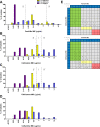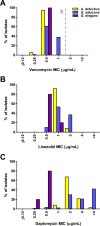Antimicrobial Susceptibilities of Abiotrophia defectiva, Granulicatella adiacens, and Granulicatella elegans
- PMID: 26666926
- PMCID: PMC4776019
- DOI: 10.1128/AAC.02645-15
Antimicrobial Susceptibilities of Abiotrophia defectiva, Granulicatella adiacens, and Granulicatella elegans
Erratum in
-
Erratum for Alberti et al., Antimicrobial Susceptibilities of Abiotrophia defectiva, Granulicatella adiacens, and Granulicatella elegans.Antimicrob Agents Chemother. 2016 May 23;60(6):3868. doi: 10.1128/AAC.00829-16. Print 2016 Jun. Antimicrob Agents Chemother. 2016. PMID: 27217443 Free PMC article. No abstract available.
Abstract
Nutritionally variant streptococci (NVS) are fastidious Gram-positive cocci comprised of the species Abiotrophia defectiva, Granulicatella adiacens, and Granulicatella elegans. NVS are an important cause of bacteremia and infective endocarditis (IE) associated with significant morbidity and mortality. Antimicrobial susceptibility testing (AST) was performed for 14 antimicrobials using the broth microdilution MIC method described in the Clinical and Laboratory Standards Institute (CLSI) M45 guideline. A total of 132 clinical NVS blood isolates collected from 2008 to 2014 were tested. Species level identification of NVS isolates was achieved by 16S rRNA gene sequencing and/or matrix-assisted laser desorption ionization-time of flight mass spectrometry (MALDI-TOF MS). Ninety isolates were identified as G. adiacens, 37 as A. defectiva, and 5 as G. elegans. All isolates were susceptible to vancomycin (MIC90 = 1 μg/ml), and none displayed high-level resistance to aminoglycosides. G. adiacens was considerably more susceptible to penicillin than A. defectiva (38.9% versus 10.8% of isolates susceptible) but was less susceptible to cephalosporins than was A. defectiva (43.3% versus 100% of isolates susceptible to ceftriaxone). Several isolates were resistant to levofloxacin (6%), erythromycin (51%), and clindamycin (10%). The MIC90 for daptomycin was ≥ 4 μg/ml for G. adiacens and A. defectiva. G. elegans isolates were 100% susceptible to all antimicrobials tested, with the exception of erythromycin, to which only 20% were susceptible. This study provides antimicrobial susceptibility data for a recent collection of NVS and demonstrates important NVS species-related differences with respect to susceptibility to penicillin, cephalosporins, carbapenems, and daptomycin. Species-level identification of NVS organisms when susceptibility testing is not readily available may aid in treatment decisions.
Copyright © 2016, American Society for Microbiology. All Rights Reserved.
Figures




References
-
- Bouvet A, Grimont F, Grimont PAD. 1989. Streptococcus defectivus sp. nov. and Streptococcus adjacens sp. nov., Nutritionally variant streptococci from human clinical specimens. Int J Syst Bacteriol 39:290–294. doi:10.1099/00207713-39-3-290. - DOI
-
- Kawamura Y, Hou XG, Sultana F, Liu S, Yamamoto H, Ezaki T. 1995. Transfer of Streptococcus adjacens and Streptococcus defectivus to Abiotrophia gen. nov. as Abiotrophia adiacens comb. nov. and Abiotrophia defectiva comb. nov., respectively. Int J Syst Bacteriol 45:798–803. doi:10.1099/00207713-45-4-798. - DOI - PubMed
-
- Collins MD, Lawson PA. 2000. The genus Abiotrophia (Kawamura et al.) is not monophyletic: proposal of Granulicatella gen. nov., Granulicatella adiacens comb. nov., Granulicatella elegans comb. nov. and Granulicatella balaenopterae comb. nov. Int J Syst Evol Microbiol 50:365–369. doi:10.1099/00207713-50-1-365. - DOI - PubMed
Publication types
MeSH terms
Substances
Grants and funding
LinkOut - more resources
Full Text Sources
Medical
Molecular Biology Databases

